John Hurrell – 9 March, 2021
Paine's delicate and faint fanciful drawings are based on half-remembered scenes in individual North American states—where it seems he has used photographs, scribbled sketches, art publications, maps and guidebooks as aids. New York is mentioned by name in the titles three times, Pennsylvania twice, Ohio and Illinois once. Also the Susquehanna River that borders New York, Pennsylvania and Maryland.
Auckland
Ralph Paine (Daniel Malone, Giovanni Intra, Ch’lita Collins, Teghan Burt)
Neverlost
18 February 2021 - 13 March 2020
The bracketing above is deliberate—my device, not the gallery’s—for in this group show I’m really only interested in discussing the Ralph Paine solo works: Tiepolo in America, a suite of seventeen graphite images made after he visited North and Central America. These drawings I want to briefly think about; exploring and ordering my cluttered brief and fleeting ideas: maybe not at all those of the artist.
Skilled in combining illustrative narrative with formal graphic invention, Paine employs soft grey (or occasionally blue) pencil with brushed-on gold or copper gouache, occasionally cutting into or smearing sections dramatically with an eraser. His elegant images usually feature dressed and naked figures, or symbolic animals (or gods) and some extra text beyond the title.
Paine’s delicate and at times faint fanciful drawings are based on half-remembered scenes in individual North American states—where it seems he has used photographs, scribbled sketches, art publications, maps and guidebooks as aids. New York is mentioned by name in the titles three times, Pennsylvania twice, Ohio and Illinois once. Also the Susquehanna River that borders New York, Pennsylvania and Maryland.
The suite’s homage-implied title seems to be cockily chortling at Paine’s role of virtuoso draughtsperson—depicting himself (a tall bespectacled gentleman wearing a top hat)—while also saluting the Rococo artist Samuel Beckett once called the maker of frescos full of ‘light and sky and sense of unlimited space.’ That ‘unlimited space’—originally discovered by Beckett in 1937 in the Würzburg ceiling (Allegory of the Planets and Continents, 1753) in Germany—can also be seen as the boundless topography of the imagination; here a second mental visit to the hugely expansive USA to check out some of its inhabitants. (Note too that a canvas version of Tiepolo’s fresco is to be seen in the Metropolitan Museum of Art in New York, and Paine may have seen it.)
Like Tiepolo in Germany, Paine is interested in assorted North American individuals, particularly those he encounters in the big cities, plus too the personalities depicted in artworks in museums. Those public spaces he also depicts.
There are also many symbols. A hawk with a piercing eye sitting high on a branch becomes a trope for surveillance. The Rod of Asclepius (a snake entwined around a baton) is depicted three times as a pharmaceutical reference—there are also mushrooms—and Paine/Tiepolo himself, four. Many contain hovering circles that seem to reference hermetic universes.
Note also that Giorgio Agamben, the Italian philosopher whom Paine greatly admires, once published a book of commentaries on Tiepolo drawings for children, focussing on the adventures of Pulcinella, a comical schemer whose devious ways Paine now recontextualises (through these self portraits) in another continent. (Maybe Pulcinella here stands for any ambitious artist routinely planning career moves.) One Paine portrait (After Agamben) refers to the philosopher’s book The Use of Bodies directly by name, providing another obvious footnote and mental toehold in these densely multi-layered works.
Paine’s swirling grey misty images have a subtle dreamlike quality. Other-worldly, they are from another era, with narratives that revel in interpretative ambiguity. A line of semi-naked prostitutes on a street could also be slaves being auctioned. A work entitled Tale of a Border could refer to the border between fleshed living and unfleshed dead bodies, clothed and unclothed ones, the United States and Mexico, wealth and poverty, or the powerful and the powerless. A vertical obelisk that serves as a civic monument from bygone years morphs into a transmitter for smart phone communications.
Quotations from artworks abound: Tiepolo’s Pulcinella frescos in Venice—with comical figures wearing elongated fezes—are of course alluded to. A woman harvesting wheat could reference van Gogh, Millet or Bruegel the Elder. Others are more definite. Paine recycles William Blake’s brutal image of a twisting bound slave being hung from a gallows by a hook through his ribs. Such horror is offset by several serene profiles of beautiful women of mixed ethnicities or descendents of slaves—referencing discussions in Agamben’s The Use of Bodies book.
Many other drawings have a sly poetic humour, pondering human stereotypes that from the titles are often intended as symbols for abstractions. A scholarly academic (perhaps Hannah Arendt?) sits on a bed intensely engrossed in her books while nearby her bored masked companion (Pulcinella / Paine /Agamben?) lies on his back casually playing with his flaccid willy—while being watched by a curious cat. A perky young woman playing a side drum in a marching band wears a see-through blouse and jaunty three-cornered hat. A tall bald man lies in a deep sleep on a city rooftop, using a decorated Mexican skull as a pillow. A sullen teenager dressed in a hoodie and jeans sits forlornly in a claustrophobic cocoonlike futurist house with no corners, surrounded by blank oval portholes.
Paine might well have his own private textual motivations for a lot of these images, based on finer discussions stimulated by copious reading, but you don’t need to be aware of the details of his internal ruminations to enjoy them. If you are fascinated by the vagaries of history and geography (how threads of narrative separate, connect and converge), and appreciate sitting at roadside café tables casually watching myriad varieties of humanity stream by, then you will greatly enjoy this richly ‘laminated’ graphic, nuanced presentation.
John Hurrell
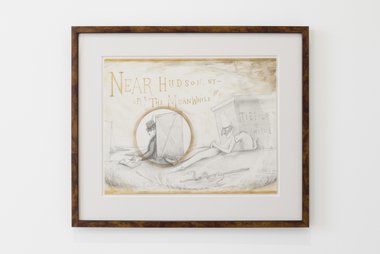



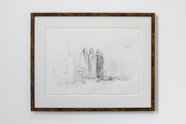
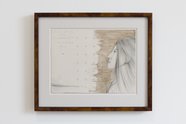
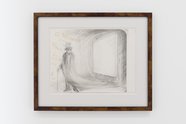

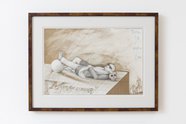






 Two Rooms presents a program of residencies and projects
Two Rooms presents a program of residencies and projects Advertising in this column
Advertising in this column



This Discussion has 0 comments.
Comment
Participate
Register to Participate.
Sign in
Sign in to an existing account.